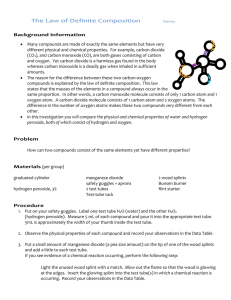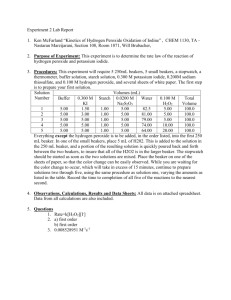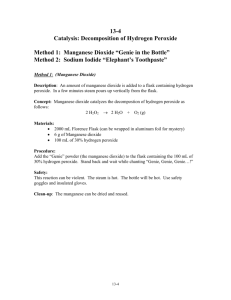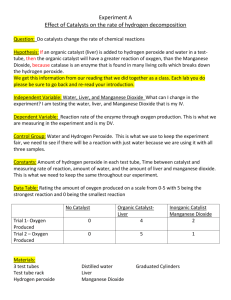Water and peroxide lab
advertisement
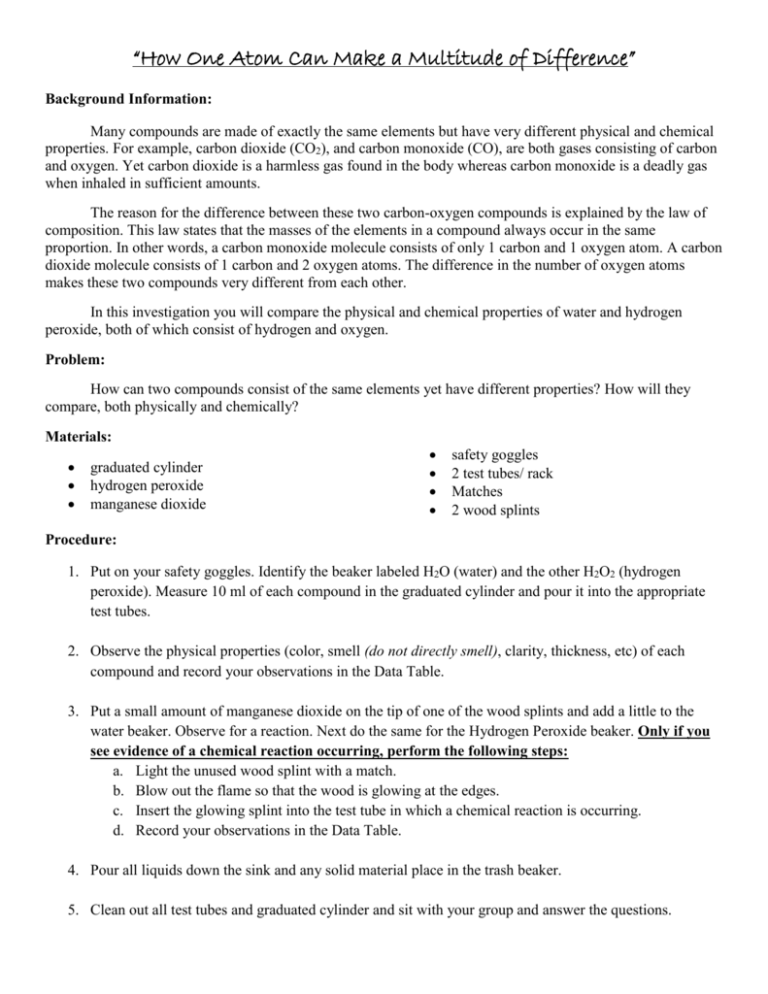
“How One Atom Can Make a Multitude of Difference” Background Information: Many compounds are made of exactly the same elements but have very different physical and chemical properties. For example, carbon dioxide (CO2), and carbon monoxide (CO), are both gases consisting of carbon and oxygen. Yet carbon dioxide is a harmless gas found in the body whereas carbon monoxide is a deadly gas when inhaled in sufficient amounts. The reason for the difference between these two carbon-oxygen compounds is explained by the law of composition. This law states that the masses of the elements in a compound always occur in the same proportion. In other words, a carbon monoxide molecule consists of only 1 carbon and 1 oxygen atom. A carbon dioxide molecule consists of 1 carbon and 2 oxygen atoms. The difference in the number of oxygen atoms makes these two compounds very different from each other. In this investigation you will compare the physical and chemical properties of water and hydrogen peroxide, both of which consist of hydrogen and oxygen. Problem: How can two compounds consist of the same elements yet have different properties? How will they compare, both physically and chemically? Materials: graduated cylinder hydrogen peroxide manganese dioxide safety goggles 2 test tubes/ rack Matches 2 wood splints Procedure: 1. Put on your safety goggles. Identify the beaker labeled H2O (water) and the other H2O2 (hydrogen peroxide). Measure 10 ml of each compound in the graduated cylinder and pour it into the appropriate test tubes. 2. Observe the physical properties (color, smell (do not directly smell), clarity, thickness, etc) of each compound and record your observations in the Data Table. 3. Put a small amount of manganese dioxide on the tip of one of the wood splints and add a little to the water beaker. Observe for a reaction. Next do the same for the Hydrogen Peroxide beaker. Only if you see evidence of a chemical reaction occurring, perform the following steps: a. Light the unused wood splint with a match. b. Blow out the flame so that the wood is glowing at the edges. c. Insert the glowing splint into the test tube in which a chemical reaction is occurring. d. Record your observations in the Data Table. 4. Pour all liquids down the sink and any solid material place in the trash beaker. 5. Clean out all test tubes and graduated cylinder and sit with your group and answer the questions. Name: Date: Period: “How One Atom Can Make a Multitude of Difference” Data Table: Compound Physical Properties (look, smell, clarity, etc) Water (H2O) Reaction with Manganese Dioxide After adding to the waterGlowing splintAfter adding to the peroxide- Hydrogen Peroxide (H2O2) Glowing splint- Analysis and Conclusions: 1. What physical properties did water and hydrogen peroxide have in common? Which were different? _______________________________________________________________________________________ _______________________________________________________________________________________ _______________________________________________________________________________________ 2. What effect did the manganese dioxide have on each compound? _______________________________________________________________________________________ _______________________________________________________________________________________ _______________________________________________________________________________________ 3. What is the difference between the formulas for the two compounds (H2O versus H2O2)? _______________________________________________________________________________________ _______________________________________________________________________________________ _______________________________________________________________________________________ 4. Explain why having a different formula would produce different physical and chemical properties. _______________________________________________________________________________________ _______________________________________________________________________________________ _______________________________________________________________________________________



